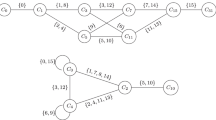Abstract
Although the representation of the real numbers in terms of a base and a set of digits has a long history, new questions arise even in the binary case – digits 0 and 1. A binary positional number system (binary radix system) with base equal to the golden ratio \((1+\sqrt{5}\,)/2\) is fairly well known. The main result of this paper is a construction of infinitely many binary radix systems, each one constructed combinatorially from a single pair of binary strings. Every binary radix system that satisfies even a minimal set of conditions that would be expected of a positional number system, can be constructed in this way.
Similar content being viewed by others
References
J. P. Allouche and M. Cosnard, Non-integer bases, iteration of continuous reals maps, and an arithmetic self-similar set, Acta Math. Hungar., 91 (2001), 325–332.
M. Barnsley, B. Harding and A. Vince, The entropy of a special overlapping dynamical system, in: Ergodic Theory and Dynamical Systems, published online: 30 November 2012, http://dx.doi.org/10.1017/etds.2012.140.
M. Barnsley and A. Vince, A characaterization of the critical itineraries of a uniform dynamical system, http://arxiv.org/abs/1205.5902v2.
M. Barnsley and A. Vince, Fractal homeomorphism for bi-affine iterated function systems, J. Applied Nonlinear Science, 1 (2013), 3–19.
G. Bergman, A number system with an irrational base, Math. Magazine, 31 (1957), 98–110.
P. Erdős, M. Horváth and I. Joó, On the uniqueness of the expansions \(1= \sum q^{-n_{i}}\), Acta Math. Hungar., 58 (1991), 333–342.
P. Erdős, I. Joó and V. Komornik, Characterization of the unique expansions \({1= \sum q^{-n_{i}}}\) and related problems, Bull. Soc. Math. France, 118 (1990), 377–390.
V. Komornik and P. Loreti, Unique developments in non-integer bases, Amer. Math. Monthly, 105 (1998), 636–639.
D. E. Knuth, An imaginary number system, Comm. ACM, 3 (1960), 245–247.
D. E. Knuth, The Art of Computer Programming, Vol. 2: Seminumerical Algorithms, Addison-Wesley (Reading, 1969).
W. Parry, On the β-expansions of real numbers, Acta Math. Acad. Sci. Hungar., 11 (1960), 401–416.
A. Rényi, Representations for real numbers and their ergodic properties, Acta Math. Acad. Sci. Hungar., 8 (1957), 477–493.
A. Vince, Digit tiling of Euclidean space, in: Directions in Mathematical Quasicrystals, M. Baake and R. Moody (Eds.) (2000), pp. 329–370.
Author information
Authors and Affiliations
Corresponding author
Rights and permissions
About this article
Cite this article
Vince, A. A combinatorial approach to binary positional number systems. Acta Math. Hungar. 143, 138–158 (2014). https://doi.org/10.1007/s10474-013-0387-8
Received:
Revised:
Accepted:
Published:
Issue Date:
DOI: https://doi.org/10.1007/s10474-013-0387-8




